If you see spiky burs covering the ground underneath a tall tree in fall, chances are you just found a chestnut tree! Chestnuts are the edible nuts of sweet chestnut trees (Castanea sativa). Sweet and nutty, these nutritious nuts are a great wild food to forage in the fall. Roasted chestnuts are a classic fall treat we all know and love, but it turns out chestnuts are a highly versatile wild food that dates back to prehistoric times!
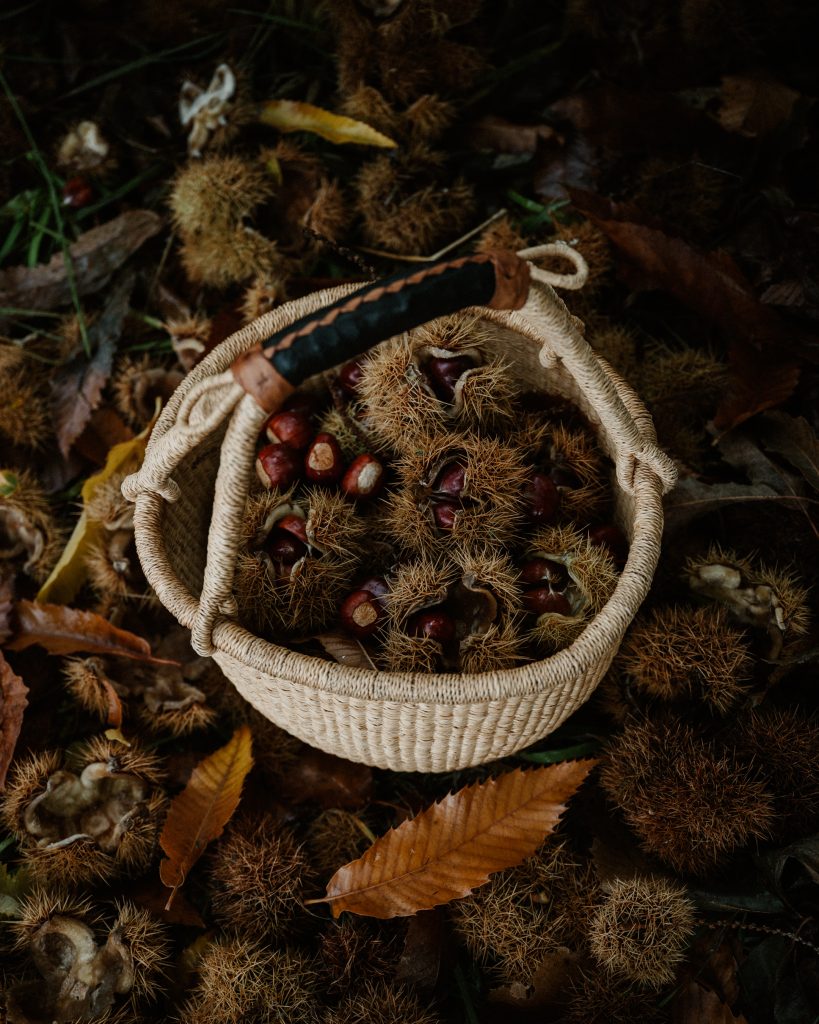
Where Can You Find Chestnuts?
Chestnuts are the seeds of large deciduous trees, genus Castanea, indigenous to Europe, Asia, and North America. Chestnuts where once so abundant in eastern North America, they were called the “redwoods of the east”.
The trees grew rapidly and were an important source of food for people and animals. The wood was prized for its resistance to rot. However, the chestnut blight, which came from chestnut trees imported from Asia, destroyed the vast majority of American chestnut trees at or around the turn of the century.
Nowadays in North America, there’s a small but growing population of sweet chestnut trees, mostly on the west coast. In Oregon, where I live, you can find chestnut trees growing in parks and by the roadside where they’ve been planted.
In Europe, sweet chestnut trees are widespread across the Mediterranean area where they enjoy the mild climate and winter rains. In the UK, they can be found in parks or planted as ornamental trees.
Apprently in Europe, chestnuts can be found for sale at just about every roadside market in the autumn! Here in North America, chestnuts can often be found at supermarkets in the fall.
Chestnut trees are beautiful trees that make a great addition to a food forest as an edible nut tree. They grow fast and can start producing nuts between three and seven years old.
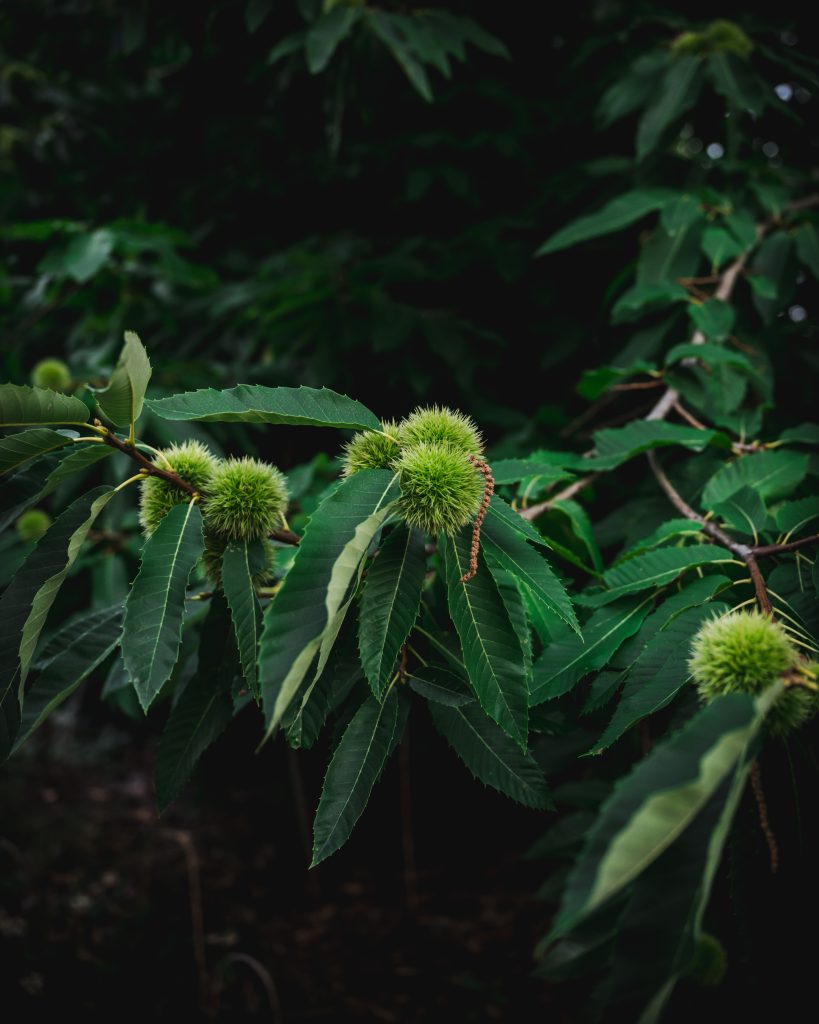
How To Identify A Sweet Chestnut Tree
Sweet chestnut trees are easy to identify with their distintive leaves, spiky burs and long, finger-like flowers. The leaves are 6” to 10” (15 – 25 cm) long and 2-4″ (5 to 10 cm) wide, and are oblong with sharply serrated edges.
The leaves turn golden brown in fall before they drop.
The spiky burs grow in clusters on the tree, and are initially green then turn brown in autumn when the chestnuts ripen. Once ripe, the burs split open and fall to the ground, covering the forest floor underneath the trees. The chestnuts are smooth and brown, with creamy white flesh on the inside.
Chestnut treees have a straight, broad trunk with deeply furrowed bark and a large, spreading canopy. The only tree you could possibly confuse it with is the horse chestnut, which has similar looking seeds, known as conkers, which are not edible.
However, the leaves on the horse chestnut are very different and the husks of the burs are smoother and much less spiky.
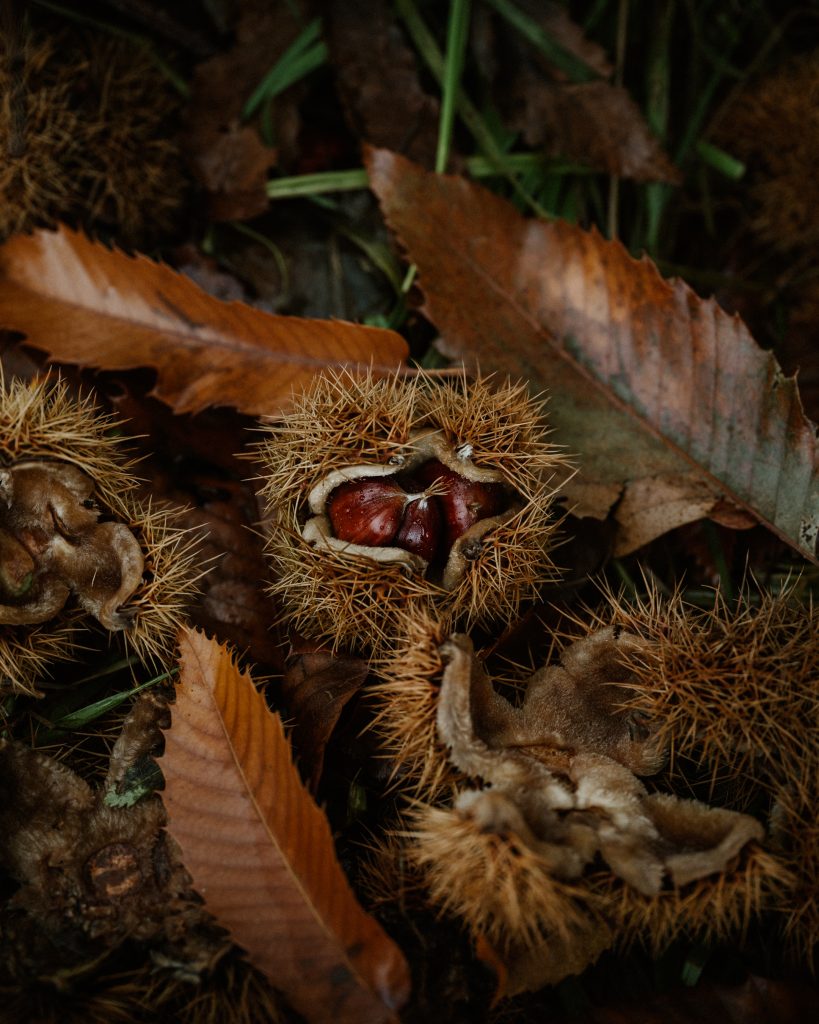
What Are the Nutritional Benefits of Chestnuts?
Chestnuts are high in sugars, especially starch. Nutritionally, chestnuts have more in common with grains than nuts. They are high in carbohydrates and fiber, but lower in both fat and protein than nuts such as almonds.
In the South of France, sweet chestnut trees are called l’arbre a pain — the tree of bread. Chestnut flour was a staple in kitchens across Europe and used to make everything from bread to cakes.
They are a great source of vitamins and minerals, particularly manganese, magnesium, copper, folate, potassium, and vitamin C.
In addition, chestnuts are rich in antioxidants, particularly ellagic acid. Ellagic acid belongs to a class of powerful plant compounds, called polyphenols, that is also found in berries, pomegranates, pecans, and walnuts.
Studies indicate that polyphenols may help reduce inflammation, improve cholesterol levels, and reduce the risk of type 2 diabetes and nonalcoholic fatty liver disease.
Interestingly, roasted chestnuts contain a higher amount of ellagic acid then fresh, possibly because the heat causes a chemical reaction that increases the concentration.
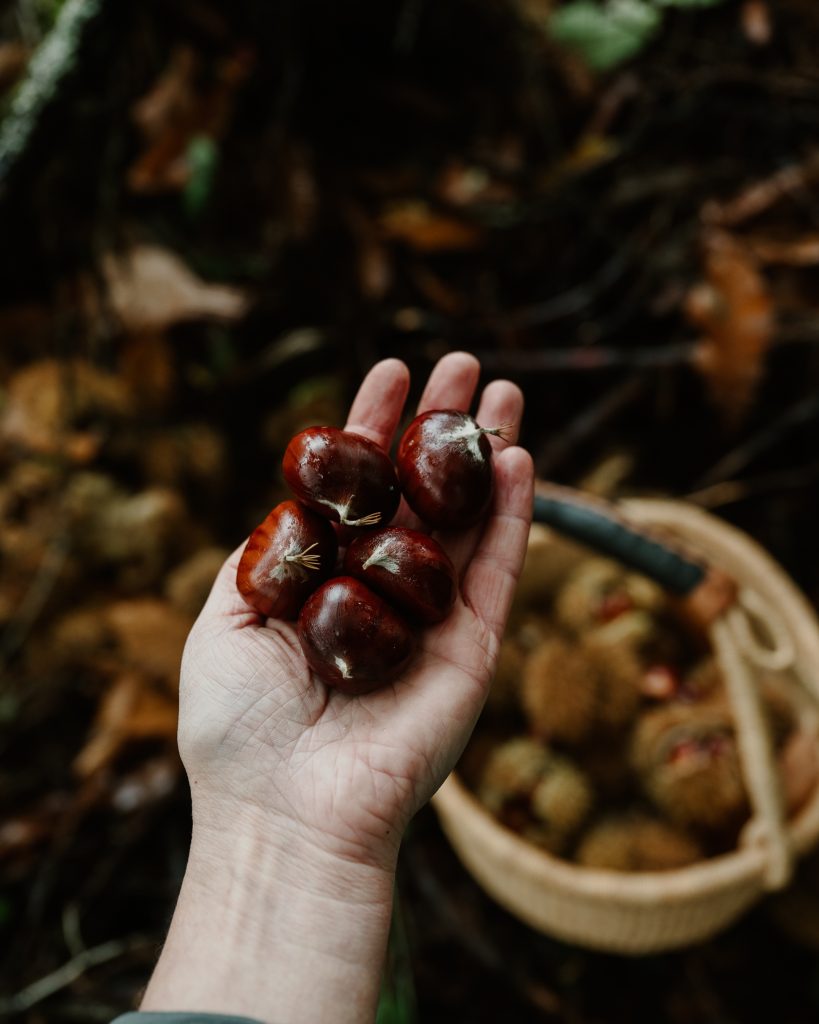
How To Harvest Sweet Chestnuts
Chestnuts are ready to harvest from September to November, though it can vary each season based on the climate. The chestnuts are ripe when they fall to the ground.
You have to be quick to pick up the chestnuts once they fall, because the squirrels love them too. A great time to gather them is after a good windstorm, which will often knock down a large quantity of chestnuts.
Wear sturdy gloves to protect your hands from the spikes. Sometimes the chestnuts will fall out of the burs, or you can pry them out of the husks using gloves or roll them under your foot to release the chestnuts inside.
Choose nuts that are plump and smooth, and discard any nuts that are wrinkled, soft, or have holes in them. They are a great wild food to forage because it’s easy to pick large quantities, and they are highly nutritious!
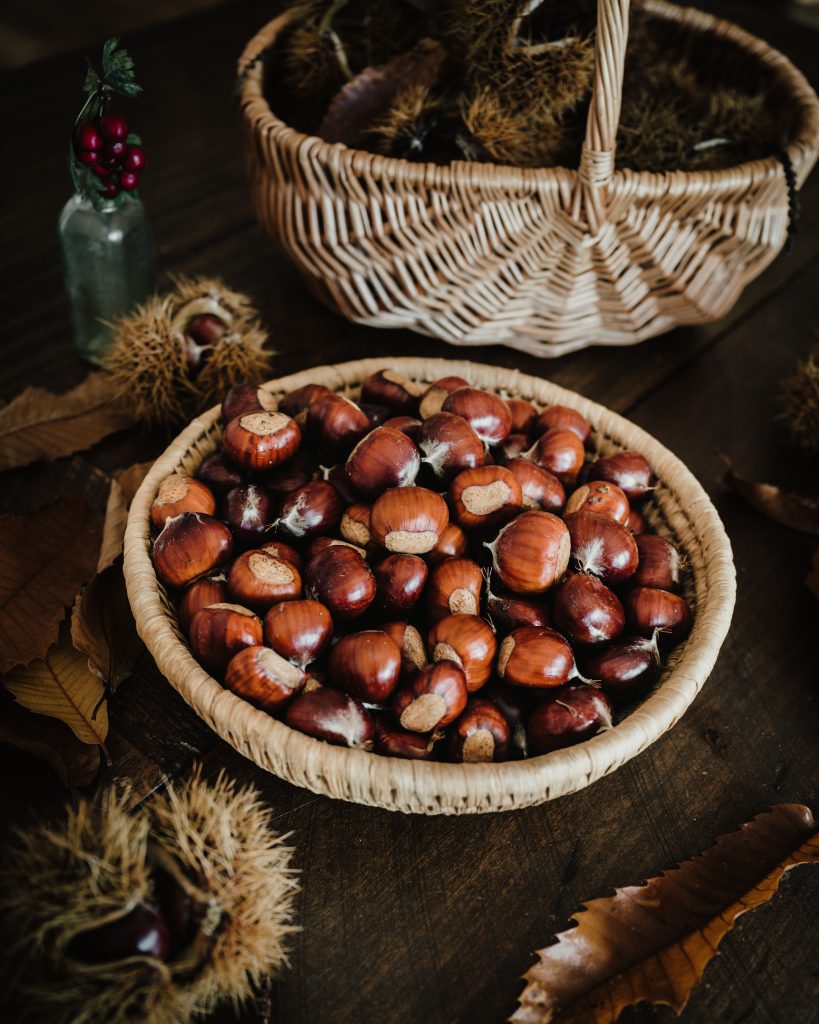
How To Prepare Chestnuts
Chestnuts are very perishable, so they need to be kept cold. Store them in a cold room or the refrigerator as soon as you get home if you can’t use them right away. If you harvest large quantities, you can also store them in the freezer in their shells until you are ready to process them, similar to acorns.
Preparing chestnuts to eat involves a bit of work. They have a thick brown outer shell and a bitter paper-like skin underneath the shell that needs to be removed before eating.
The easiest way to remove the shell and inner skin is to score the outer shell with an “X” and then either roast or boil the nuts. Then, working quickly while the nuts are still warm, peel the chestnut out of the shell with a knife which takes the inner skin off too.
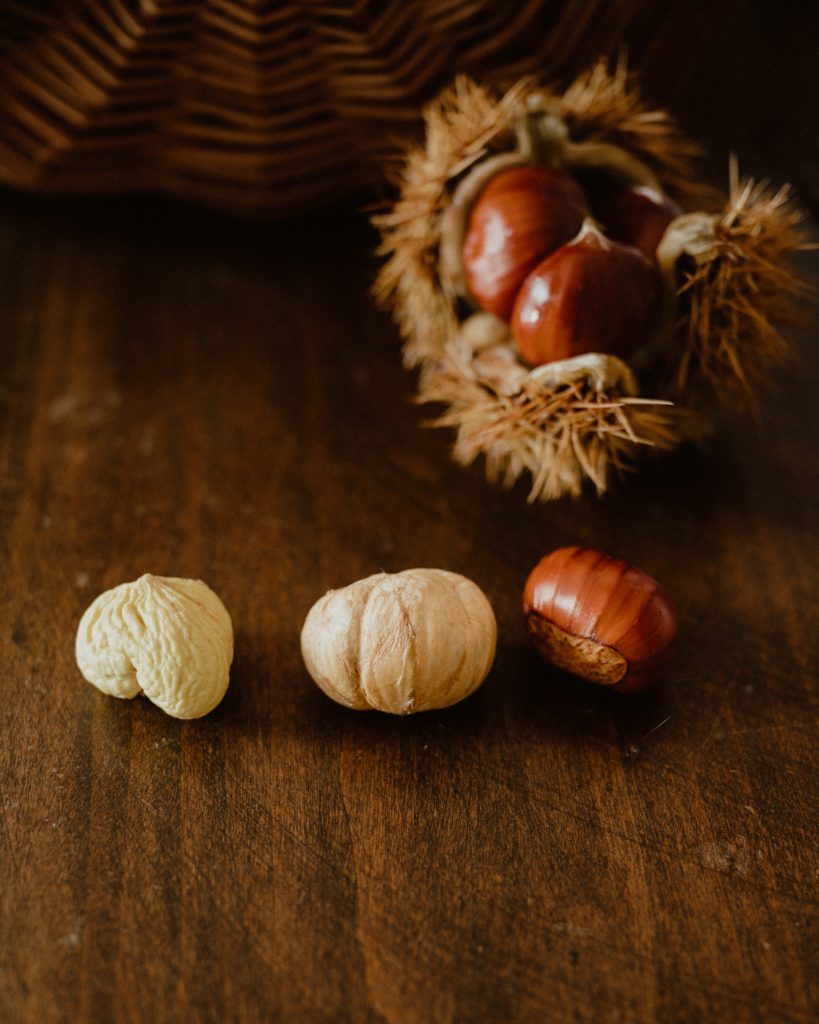
How To Roast Chestnuts
Chestnuts are incredibly easy to roast, whether it’s classically over an open fire or in the oven. Roasting chestnuts keeps them dry, which is ideal for snacking or for using them in salads. Roasted chestnuts tend to be a bit sweeter, and can be ground into chestnut meal to bake with.
Equipment:
–Sharp paring knife
–Cast iron pan or pan for roasting in oven
–Heat proof gloves
Directions:
Using a sharp paring knife, carefully score an “X” on the flat side of the chestnuts.
Place the chestnuts on a baking sheet with the scored side up. Roast for 12 to 15 minutes at 375° F. Turn them and roast for an additional 10 minutes on the other side.
The nuts are ready when the X’s pop open revealing golden brown nut flesh. While the nuts are still warm, remove the hard outer shell and thin inner skin before eating them or using in a recipe.
To roast on an open fire:
Use a cast iron pan and heat proof gloves. Place the scored chestnuts in a single layer on the bottom of the pan.
Place the pan over hot coals and roast for 5 minutes to heat the chestnuts. Stir them for an additional 5 to 7 minutes.
Remove the pan from the fire. When cool enough to touch, remove the outer hard shell, and serve warm with a touch of butter and salt.
What Do Roasted Chestnuts Taste Like?
Roasted chestnuts are soft, buttery, sweet, and slightly nutty. They have a pleasant chewy texture and are delicious eaten warm!
Sprinkle with a little sea salt or melted butter and serve them immediately after roasting for best flavor.
How To Boil Chestnuts
For using chestnuts in soups and purées, score them and place them in a pot of water.
Bring the water to a boil, then lower the heat and simmer for 15 minutes.
The nuts are ready when the X’s pop open revealing the inner nut flesh.
Remove the hard outer shell along with the inner paper skin before eating or using in a recipe.
Resources
No Comments